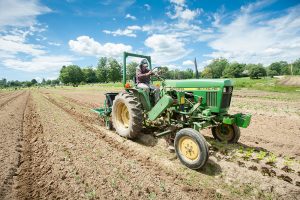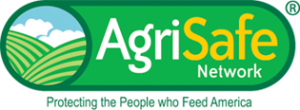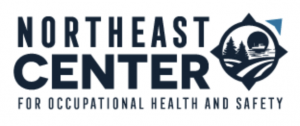Farm Safety
Agriculture is one of the most dangerous occupations in the country. “The National Institute of Occupational Health and Safety (NIOSH 2013) estimates that on average 243 agricultural workers suffer lost-work-time injuries each day, with five percent of those injuries resulting in permanent impairment.” Many farm fatalities and injuries can be prevented.
Farmers perform chores, which pose threats to their health and safety. They are repeatedly exposed to noise, chemicals, dust, mold and the risk of physical injuries. Personal Protective Equipment (PPE) has been proven to prevent injury and promote farmer’s health. Improving availability of PPE and encouraging proper use could reduce the risk of injury and illness.
Resources
Tractor Safety Video Training Series from UMaine Cooperative Extension. This  video series is designed for training farm crews, training young family members who are around farm equipment, and for self-learning for new and experienced tractor operators. Topics include Principles of Tractor Safety, Avoiding Tractor Rollovers and Run-overs, Hazard Awareness around Older Tractors, and Tractor Power Take-off Safety.
video series is designed for training farm crews, training young family members who are around farm equipment, and for self-learning for new and experienced tractor operators. Topics include Principles of Tractor Safety, Avoiding Tractor Rollovers and Run-overs, Hazard Awareness around Older Tractors, and Tractor Power Take-off Safety.
 The AgriSafe Network is a national non-profit organization of health professionals and educators who are concerned about the health and safety of farm families. Many agricultural injuries, diseases, and fatalities can be prevented through the delivery of agricultural occupational health services. AgriSafe services include continuing education via workshops and webinars, technical assistance, and updates on the most cutting-edge developments in agricultural health and safety.
The AgriSafe Network is a national non-profit organization of health professionals and educators who are concerned about the health and safety of farm families. Many agricultural injuries, diseases, and fatalities can be prevented through the delivery of agricultural occupational health services. AgriSafe services include continuing education via workshops and webinars, technical assistance, and updates on the most cutting-edge developments in agricultural health and safety.
 Additionally, the Northeast Center for Occupational Health and Safety in Agriculture, Forestry, and Fishing (NEC) has created a PPE program that offers a variety of selected products that are affordable and appropriate for farmers across the country.
Additionally, the Northeast Center for Occupational Health and Safety in Agriculture, Forestry, and Fishing (NEC) has created a PPE program that offers a variety of selected products that are affordable and appropriate for farmers across the country.
What are you doing to make sure you and your family and farm workers are safe?
- Review Farm Safety Rules
- Know where the First Aid Kit is, and know how to use it
- Keep your cell phone with you at all times
Cooperative Extension Publications
Cooperative Extension publications help “extend” University of Maine resources to the public. To browse the full catalog choices, go to the publications page.
Here are links relevant to farming and farm safety:
- General Agriculture
- Maine Farm Safety Program
- Business & Community
- Ag Safety and Health from eXtension.org
Farm Safety for Families
Agriculture is one of the most hazardous industries in the nation. With injury rates highest among children age 15 and under, farmers and farm families need to be aware of the dangers for children. Farm equipment is a source of curiosity for children and tends to draw them towards work areas. It is the farmer’s responsibility to provide education and continued training regarding safe work practices. Read the entire article.
Preventing Slips, Trips, and Falls
Did you know that falls are the 3rd leading cause of unintentional deaths? With the warmer weather, many more people working outdoors using ladders. Be sure to:
- Always read safety labels and warnings on ladders.
- Inspect ladders for damage before use — do NOT use if unsafe.
- Don’t stand any higher than the third rung from the top of the ladder.
- Only use ladders as intended- don’t use as a bridge or scaffolding.
